Note: make sure you familiarize yourself with part one of this brisket tutorial, linked HERE.
Part Deux: Alternatives
There are many ways to break apart a brisket, and they are all wrong according to somebody. I do them several different ways myself, depending on preference and whim; I’m sure there is a pitmaster out there who thinks ALL of my approaches are incorrect. That is the great thing about not actually owning a restaurant. There is nobody to complain, nobody to demand a refund.
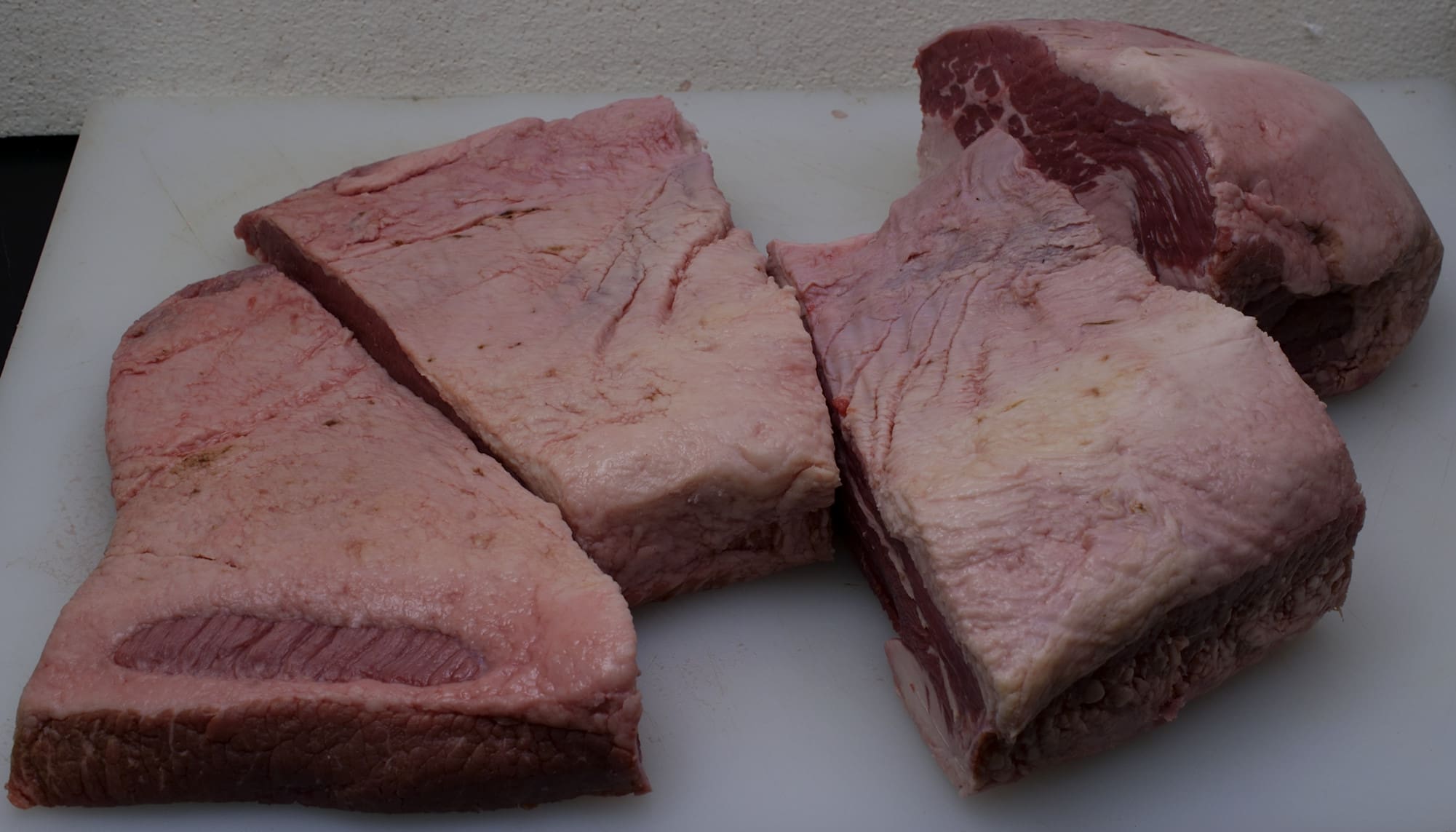
Simplicity reigns supreme. The brisket can be just cut it into pieces–four, in this case. No trimming, no separating of the inner and outer pectorals. The fat really is a little bit easier to remove after processing, but ultimately it boils down to preference. When you cut apart the brisket this way, you get two pieces that are mostly from the flat. Below–the end piece, all flat.

The other two pieces will combine point AND flat because the flat runs almost the full length of the brisket.

The point runs about half way. Below–all point.

The heart of the matter
Brisket has the reputation of being fatty. And for good reason. It IS very fatty. Didn’t this animal get any exercise? Actually, the pectoral muscles of a steer/heifer support the bulk of the weight of the animal.
These muscles are almost as strong as the cheek muscles–the stronger the muscle, the higher the collagen content and the tougher the meat. Domesticated cattle don’t move around a lot–we are their only predators. The front end of a cow is a LOT heavier than the rear end because of the size of the chest cavity, shoulders and the head. A cow’s head can weigh thirty pounds.
Elite meat
We saved some time by not trimming the brisket. Now I’m going to do something that I almost never do, something that I tell people NOT to do. Most novices cannot resist the temptation to season the bag, especially when they first discover sous vide. Surely the confinement to the vacuumed pouch forces flavor into the meat. Unfortunately, and decidedly unromantically, the science does not support this notion.
Meat is a tangled matrix of complex protein chains. Salt (actually sodium ions) can penetrate the web and even the cell walls because sodium ions are extremely small, even by the standards of atomic scale. That is a normal, necessary function of a living animal that extends post mortem. Meat curing depends on sodium’s ability to cross over the cellular membrane, albeit very slowly–at the rate of about 1″/3 cm per week. Flavonoids and other molecules–even sugar–are just too large to penetrate the matrix. That would create a real problem for a living animal. These processes occur much more slowly after the animal’s blood stops circulating, but don’t take my word for it. We are going to demonstrate it.
Yes it does, no it doesn’t!
The debate of whether to season the bag is enduring and will probably never be resolved. Is the ocean blue because of the sky, or is the sky blue because of the ocean? Science answers these kinds of questions definitively but there is enough distrust of science and scientists for people to indulge themselves in these arguments ad nauseum. Controversies like this take on lives of their own.
I will not subject you to the finer points of the dispute. We will just season some bags and see what happens. Of course, the ingredients/marinades/slurries/rubs might provide color. They might cling to the surface to a slight degree. Remember though, meat sweats when it gets hot. The protein is releasing moisture that tends to remove whatever might be on the surface.
Bouquets without the wedding
Fresh herbs and vegetables require 183 F/84 C in order to cook–to denature. This temperature is much higher than one would use for protein. The roast may take on the hue of bag contents like paprika or caramelized extracts –but, remember–color is not flavor, and flavonoids are colorless. They may be ACCOMPANIED by dyes, but they are distinct from them. When you open the bag, you will detect the aroma of the seasonings–very nice. You might also notice that the bouquet dissipates after 2-3 minutes, and is then lost forever.
I suppose you might gather your guests together for the ceremonial opening of the bag so that they can appreciate the heavenly scent. Emptying the sous vide bag is not very flashy. To paraphrase a famous German politician, removing the meat from the pouch is a lot like politics and sausage–it’s usually better if the general public does not know what goes into it. Rather than call everyone into the kitchen to participate in the ritual, you might better resign yourself to being the only designated beneficiary of this burst of aroma. You can always tell them about it.
Spongeworthy?
I mentioned that as the temperature of the pouch increases, the meat “weeps.” Moisture comes OUT, but nothing really goes in. Salt cannot reverse the direction of heat driven moisture release. It’s rather like dipping a wet sponge in a sink full of hot saltwater, squeezing it, and then removing it from the brine. Is there going to be salt inside the sponge? Not likely. This is disappointing at first but saves a lot of wasted effort later.
When it comes to taste, the brain depends on the eyes, nose and even expectations to evaluate stimuli. Allergy sufferers start sneezing when they see vivid pictures of blooming gardens. It may not actually matter if flavor is being imparted or not. Maybe someday computer screens will have scratch and sniff capabilities. I expect to be long gone by then. Just remember I told you so.
Let’s do it again
Most people who season the bag admit to re-seasoning the meat after sous vide processing anyway. That should tell us something right there. Why do it twice? Marketers of spices and sous vide equipment would have us believe that their products defy physics–and they have done a good job of it so far. We want desperately to believe in infusion and flavor penetration, before, after, during, whenever.
I, too, was fooled at first. Upon further research, findings, and contemplation, I concluded that I didn’t want the inside of the meat to taste like the crust on the surface anyway. It is the distinction between the two sensations that excites our palates–the initial explosion of flavor followed by the unique and pleasing texture and flavor of meat. There are foods that have the same flavor on the inside as on the outside. Oatmeal, for example. Bananas. Is that really what we want? Do we want the inside of a slice of bread to taste like crust?
True colors
We will stage the roasts into the oven without adding any more seasonings so that we can observe the results. We will not delude ourselves into believing that our ultimate evaluations are objective. We will just decide whether we like it or not. We will do the best we can.
The Fantastic Four
We used four concentrated flavorings/colorings. They all have salt. Three of them have what we now call “umami.” We used to call it mono-sodium glutamate or ajinomoto, but then we were told that MSG is of the devil and should be avoided at all costs. Now we just use a euphemism to refer to it and/or let somebody else apply it. It’s like the salt and “butter” on theater popcorn. We know it’s bad for us, but we didn’t put it there, so it’s not our fault–you are not going to take our popcorn away from us even if it kills us. As it turns out, it’s not as bad for us as alarmists would have us believe.
Hondashi Brisket
Japanese Hondashi is a flavoring base used to make Miso soup. It has three basic ingredients. Dried bonito (tuna) salt and MSG. By weight, the bonito occurs in the smallest amount. It’s pretty tasty.
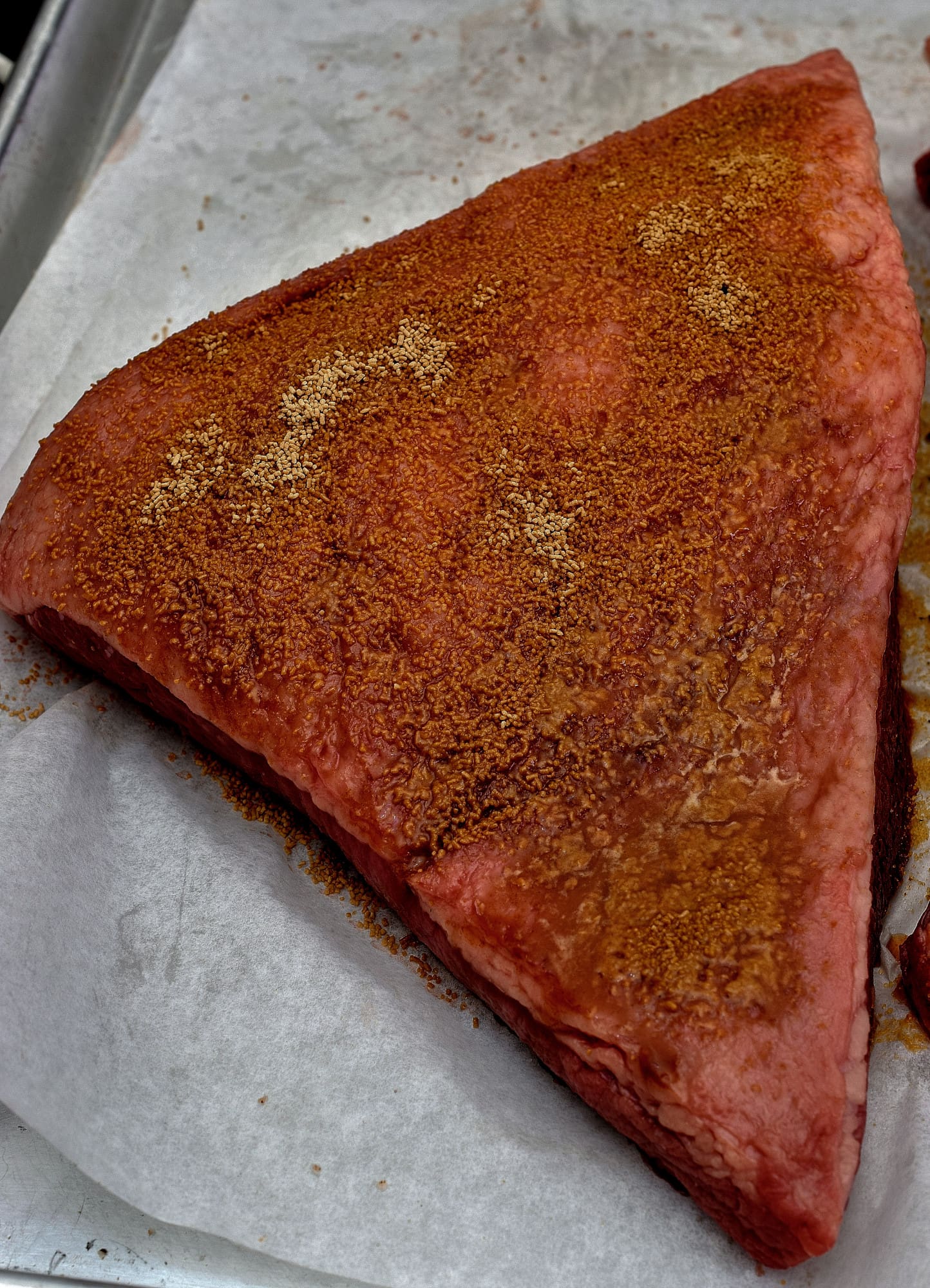
Surf’n’Turf notwithstanding, Americans get a puzzled look on their faces when recipes combine land or air dwelling animals with seafood flavorings. The rest of the world has no such hesitation. We turn a blind eye to the knowledge that Worcestershire sauce, Caesar Salad dressing and most steak sauces have anchovies in them. We want our umami, but we don’t want to know how it got there.
Chicken Flavored Brisket?
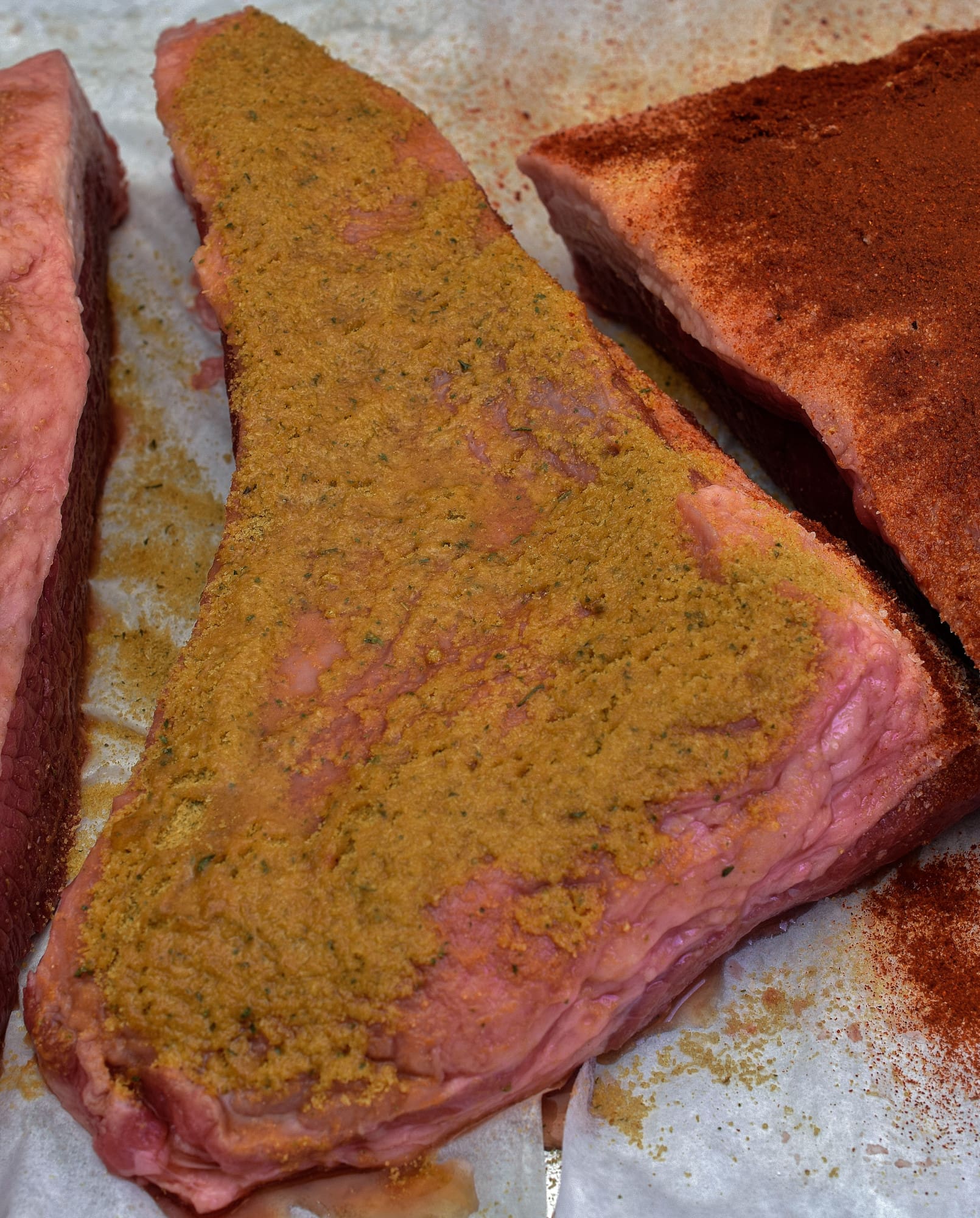
Chicken bouillon is another of those flavor packed things that we pretend to disfavor. We don’t want to admit that we use it. But how else do you get that flavor, even if you make your own stock? Again, glutamates and those bright yellow colorings (turmeric). Apply generously. Some recipes say to rub it in well. Sure, knock yerself out. It’s going to dissolve in there anyway, but have at it.
Beef Flavored Brisket, Heaven!
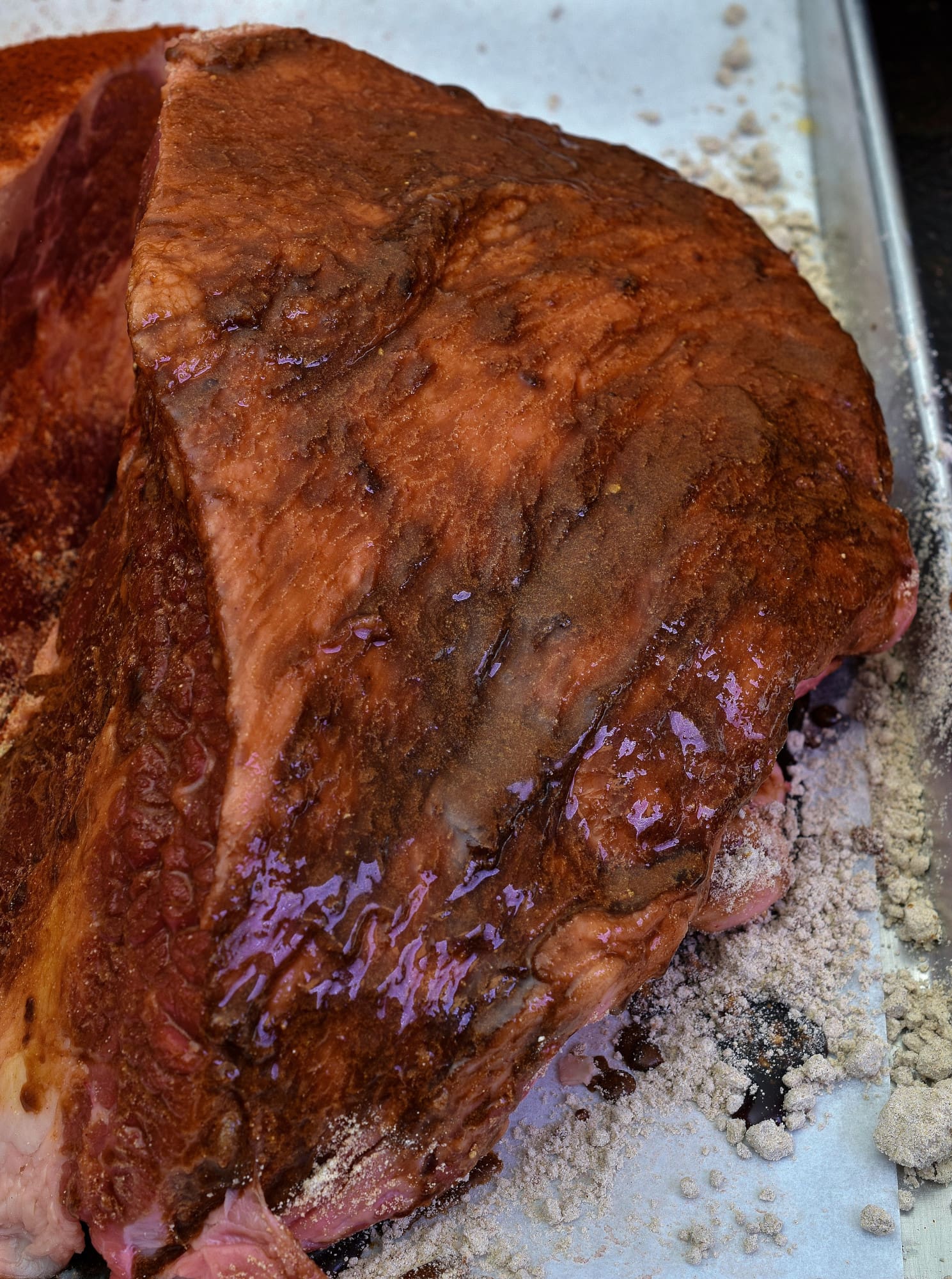
I used some of that dried brown gravy powder moistened with the liquid beef base flavoring. Very umami-ish.
Rubbed Brisket
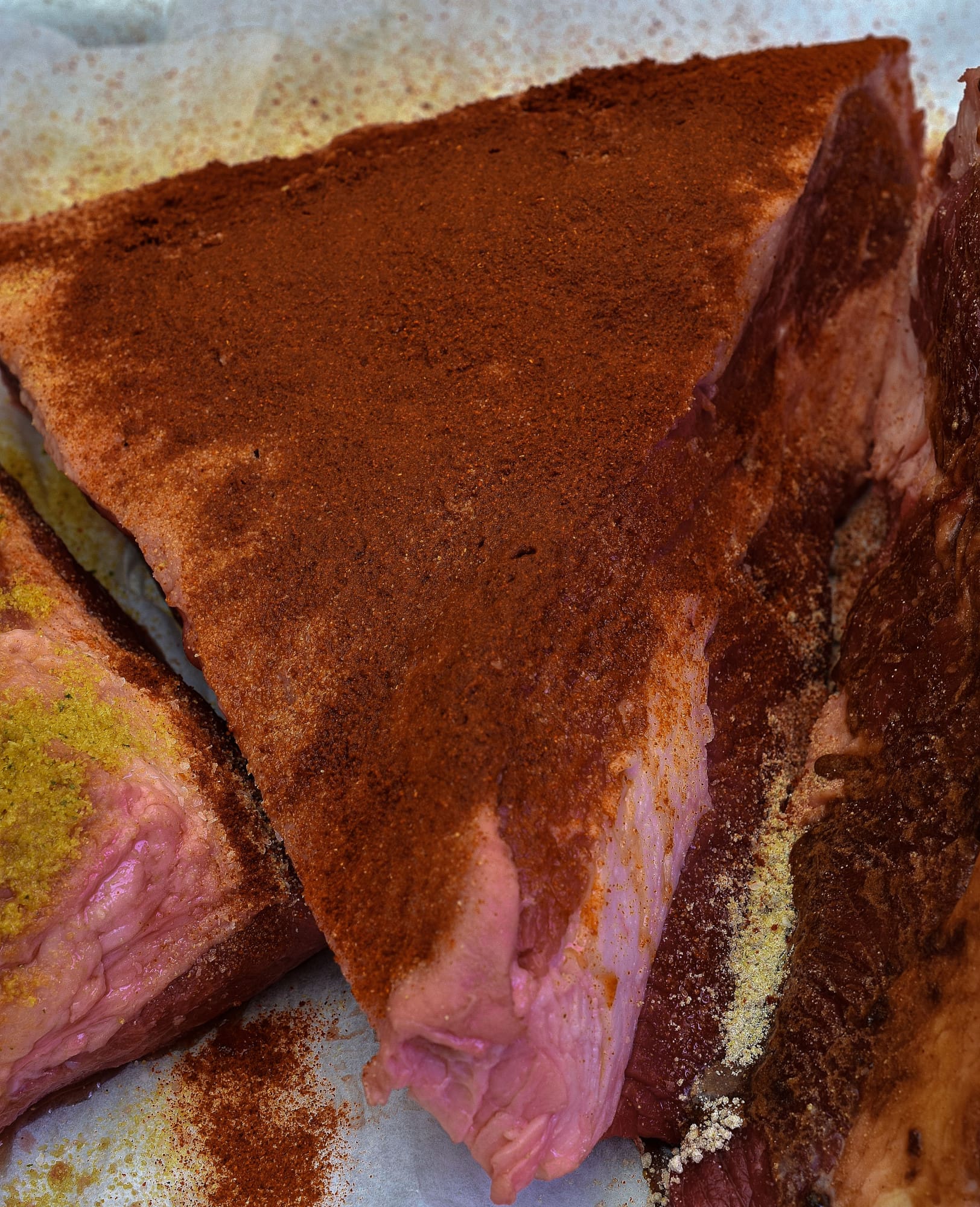
The all-too-familiar, catch-all BBQ seasoning. Salt, pepper, paprika, garlic powder, sugar, etc. No MSG in this version.
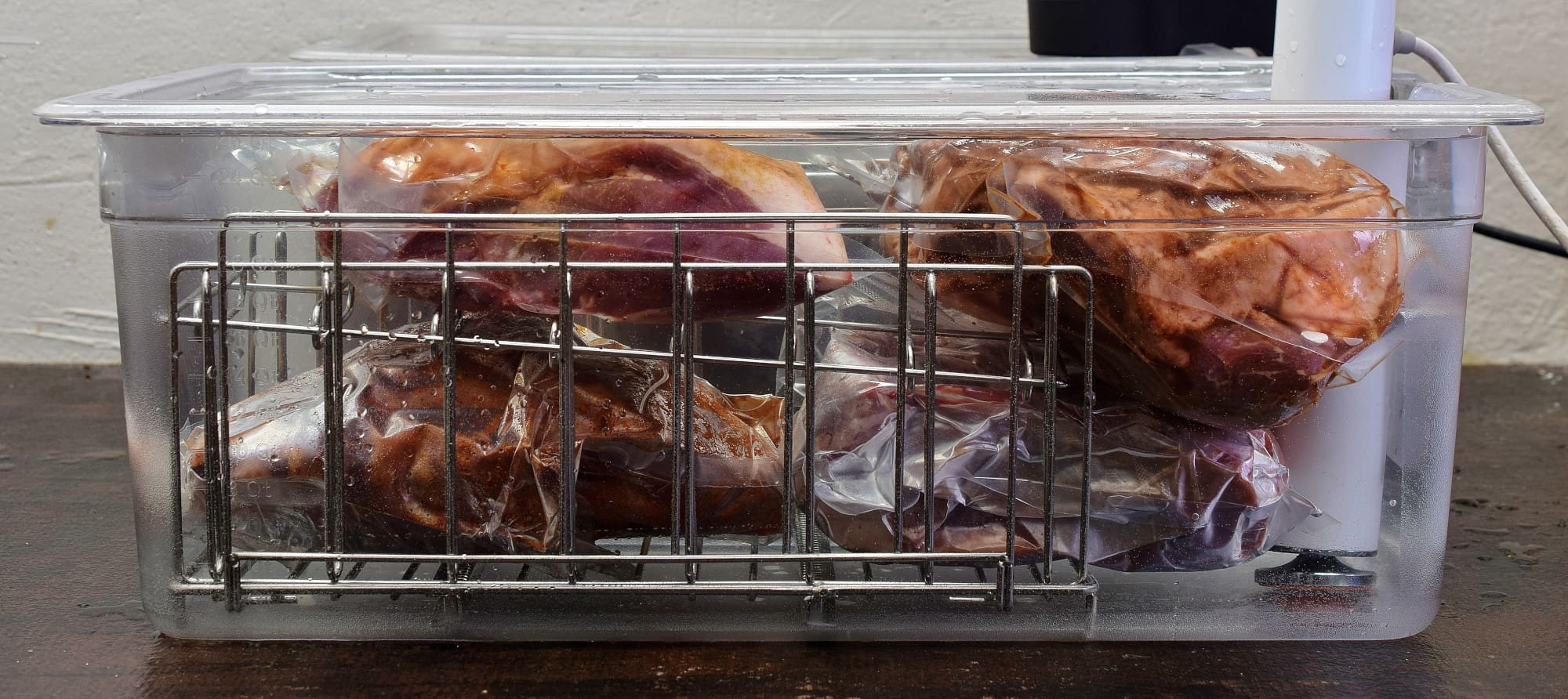
Preheat the sous vide bath to
140 F/60 C
In the bags they go. It’s a good idea to double bag these because the first bag collects a lot of the seasoning in the opening and may not seal properly. Put the first bag in another bag.
Process the packages for
48 hours
When the interval has elapsed, cold shock the packages in iced tap water until they achieve 70 F/21 C. How can you tell? After whatever ice has melted, and with the tap turned off, measure the temperature of the water–it should be about 70 F/21 C. Come back in fifteen minutes and measure the temperature of the water again. If it has gone up, drain and fill the container again with cold tap water. When the temperature of the water holds at 70 F/21 C, the packages are ready to be refrigerated at 40 F/4 C until you are ready for the next step.
The Excitement Builds
Preheat the oven to
350 F/176 C
Note: A hot smoker or basic barbecue oven can be used if you have the facilities. I usually assume that people don’t have a complete outdoor cooking facility rather than to assume that they do. Any temperatures between 180 F and 400 F can be used, as long as the internal temperature of the roast achieves at least the original target temperature.
Dip the package(s) in hot tap water (or a sous vide bath) until the gel melts–about 2 minutes. Position a strainer or colander over a 1 quart/1 liter container. Line the strainer with two moistened paper towels. Moistening prevents the sous-jus from clinging to the towels. Cut the corner of the bag and drain the liquefied purge into a deep microwaveable container.
Separating the wheat from the chaff
Bring the juices to a boil and pour through the paper towels. The debris left behind is composed of coagulated albumins, myoglobin, and the spices that we put in the bag. If you taste this jus, you will see that it has a considerable amount of salt in it–this confirms our suspicion that the meat doesn’t have time to salinate. Wishing just won’t make it so.
Some devotees season and seal the bag and then refrigerate overnight or even longer before processing. This is generally safe, but you may achieve a partial cure–one where the salt penetrates the surface but does not travel all the way to the center of the meat. This can create a two-tone tint in the meat. People who cure their own meat go to great lengths to prevent this. In my opinion? Either cure it or don’t cure it–one or the other. Pick a lane and stick with it.
Set the timer for 90 minutes.
Hondashi Brisket
Note the color of the brisket, not that there is anything extraordinary about it. Dissolved in water, Hondashi is sort of a pale tan.

And that tan color is represented in the clarified jus. Roast the brisket as prescribed at
350 F/176 C for 90 minutes.
Ovens vary in their efficiency and even temperature accuracy. As a general rule, the roast should achieve at least the original processing temperature–140 F/60 C. We will use the same temperature and time parameters for all four samples.
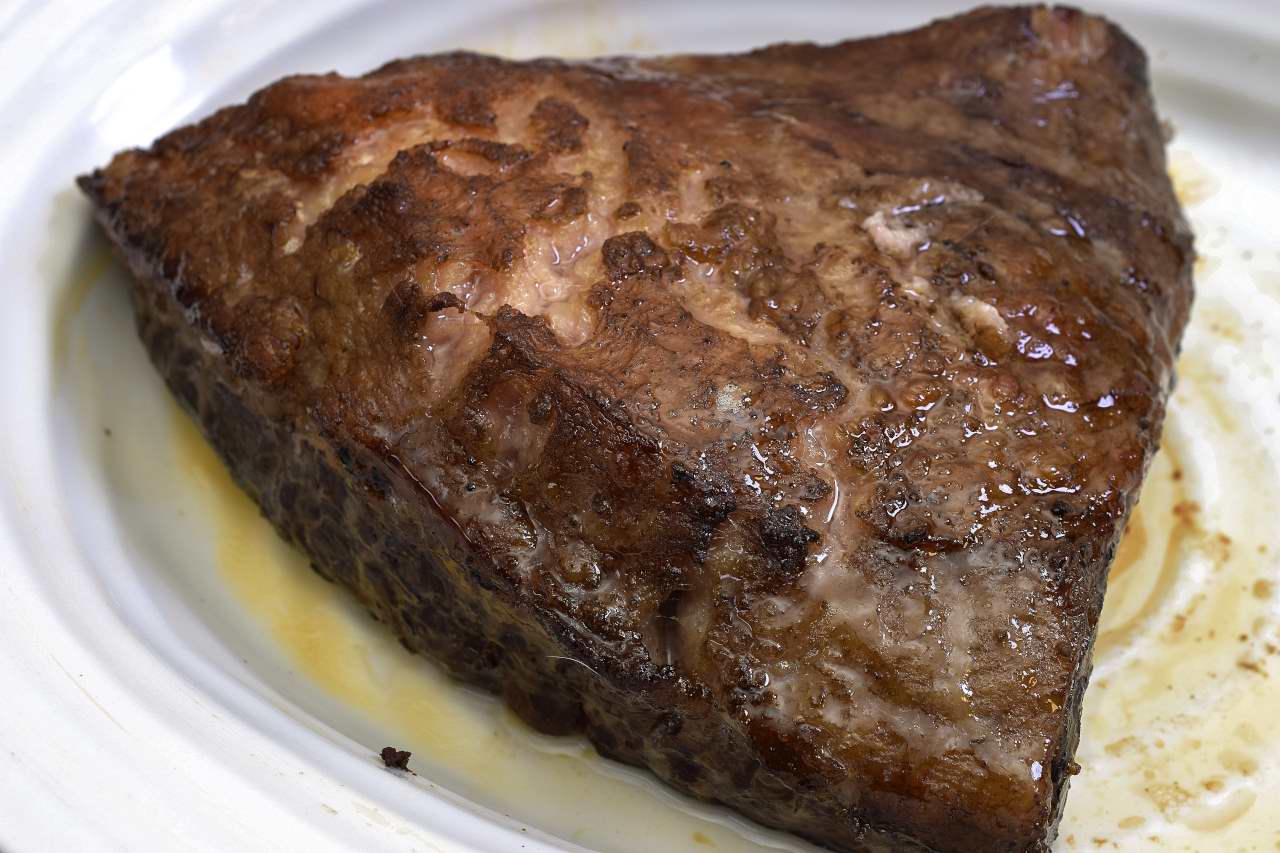
Again, note the overall color so we can compare it to the other samples.

Some people seem to think that 140 F/60 C is “medium,” and there is no accounting for preference or opinion required. For me, this is well done.
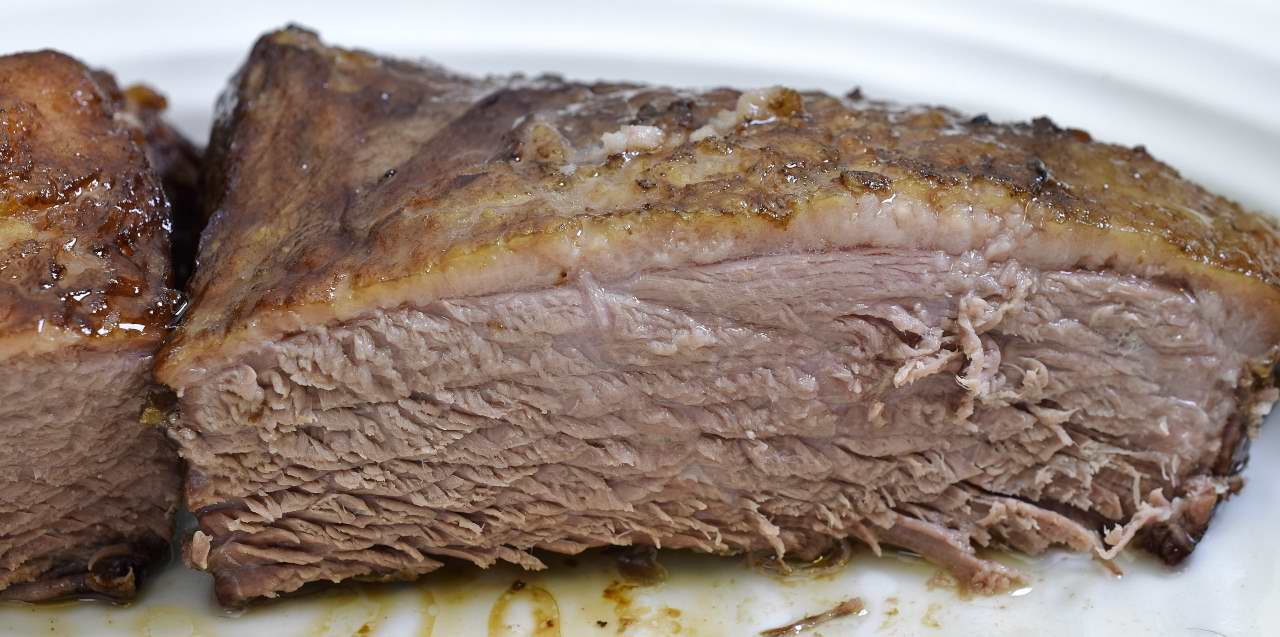
Brisket Chicken

The color of the clarified jus is indistinguishable from the Hondashi model, at least to my eyes.
350 F/176 C for 90 minutes–see additional notes above.

To my eyes, this chicken flavored roast is not appreciably different in color from the Hondashi model.
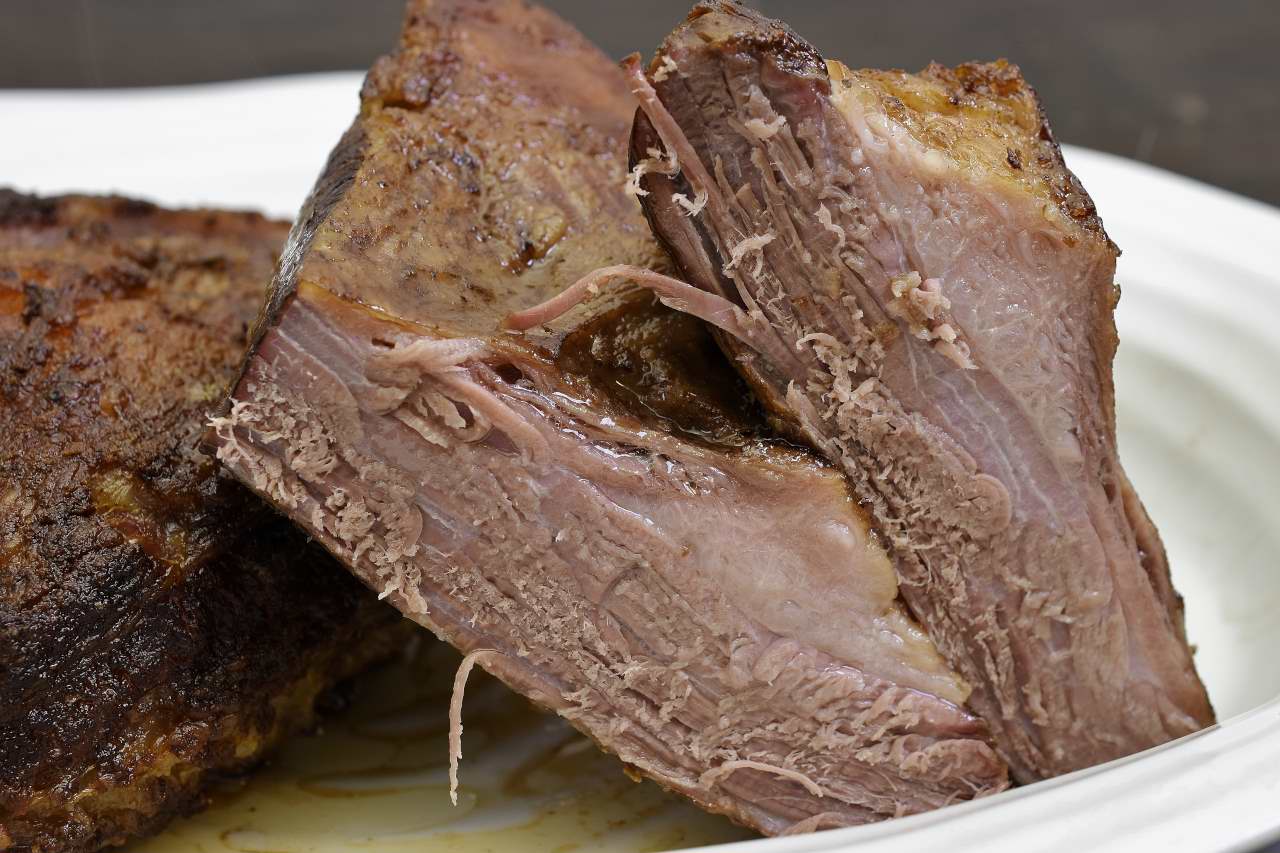
I wouldn’t expect it to be a different color inside–and it’s not.
Brisket, Beef Flavored

Results! Yes, the jus is somewhat darker than the Hondashi and Chicken powder models.

The roast came out darker, but all ovens have hot spots and I cannot say for sure what caused this. Even so…

Inside: no visible difference (as expected).
Basic rub model:
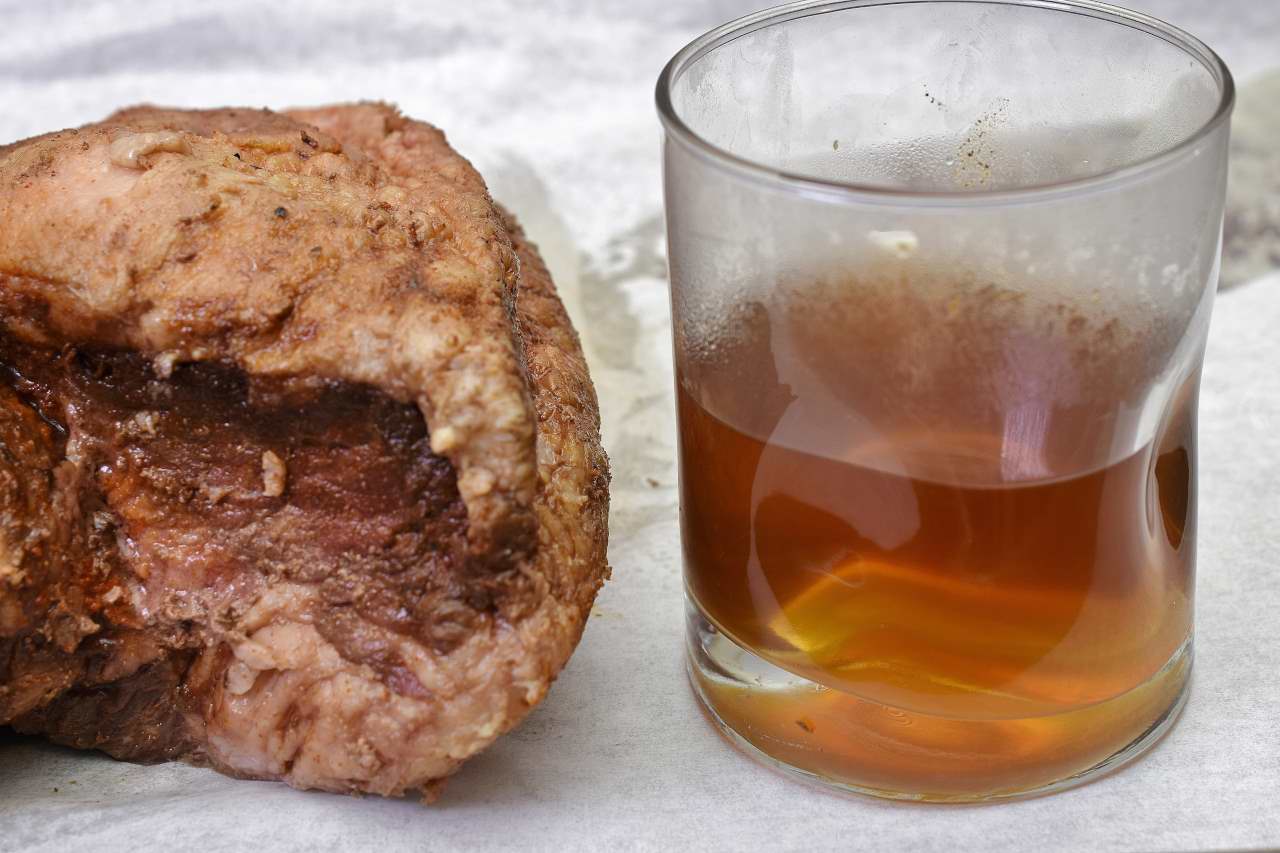
The color of the clarified jus is darker than the Hondashi and Chicken models, but not as dark as the Beef version.
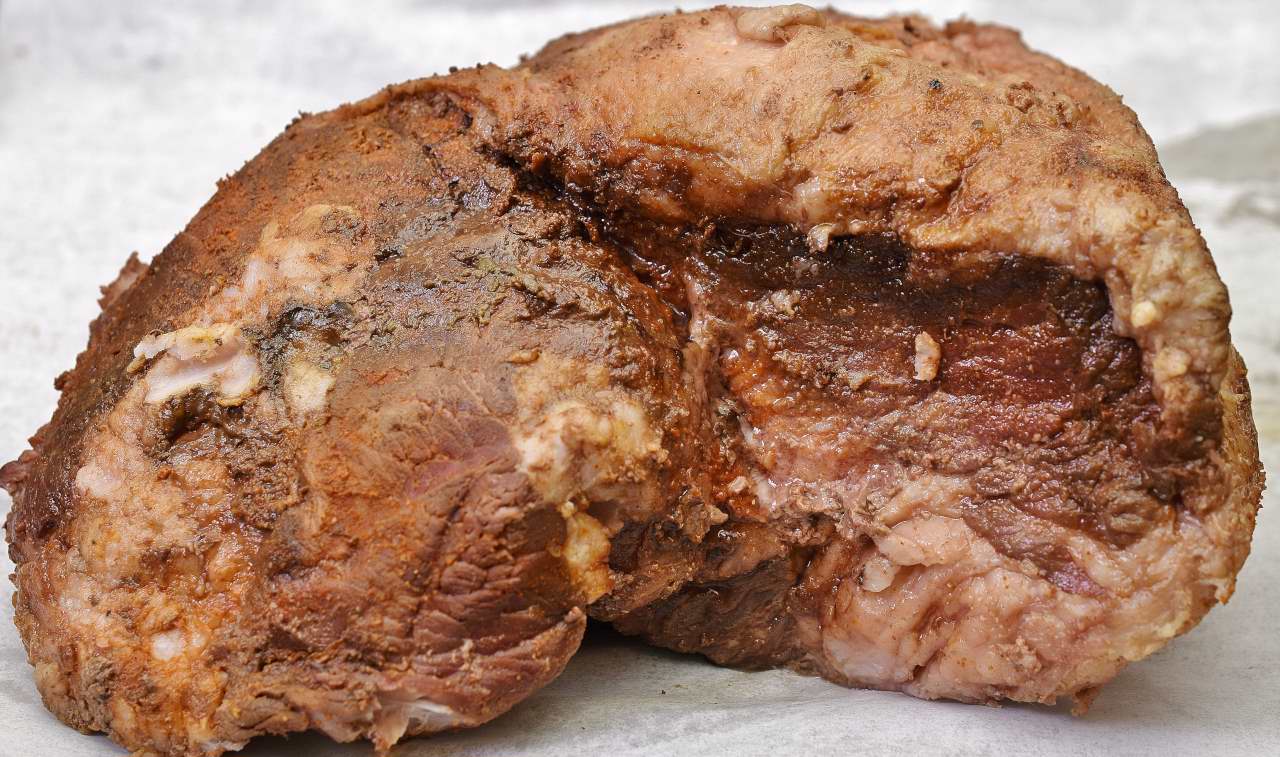
350 F/176 C for 90 minutes–see additional notes above.

This definitely has the reddish brown color associated with roasted paprika, so we are at least retaining some color with this version.
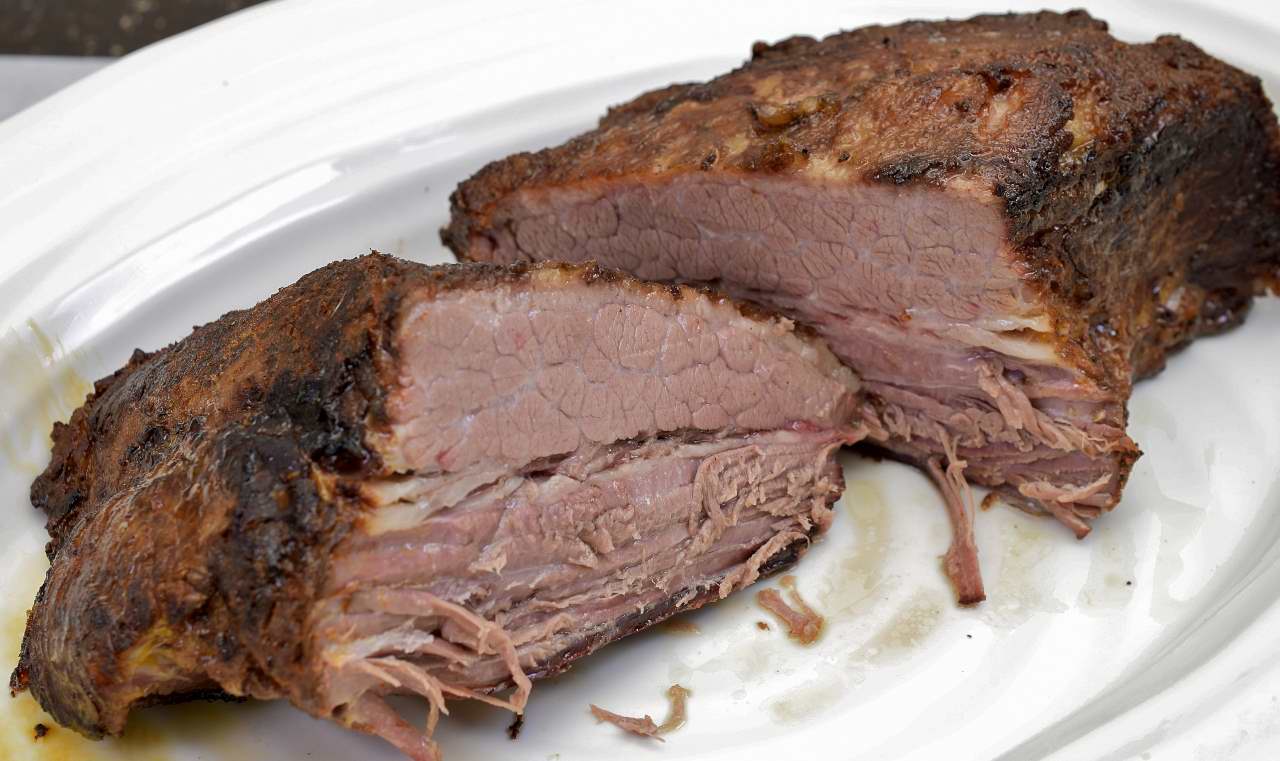
Inside? No difference.
Every which way from Sunday
The samples of jus all tasted as we expected–exactly like the ingredient applied, and well salted. We expected that.
I am not a super taster–some people have as many as twice as many taste buds on their tongues as others. Actually my wife is a super taster, and she is fairly typical. She is a waif, a slender thread, less than 100 lbs. Super tasters are known for finding the flavors of most foods satisfyingly strong, sometimes discouragingly strong. They can’t imagine how other people can eat so much.
I marked all the roasts, trimmed the surface fat and recruited my wife, my able assistant. I closed my eyes. I went back and forth, I rinsed and repeated. She cut and logged samples from the outside, the inside, the bottom and the sides. Nothing. Nada. Zip. Zilch. Nichts. Rien. No difference. When I was done, I managed to persuade her to taste a few samples.
She was bored, but she bore with me. I didn’t even tell her what the flavorings were or which was which. No difference. Salt on the surface. Don’t get me wrong. It was good. But the seasonings did little or nothing–the juices can just as easily be seasoned after processing, and more efficiently so. Sorry, guys.
Norm King
Epilogue: Then what?
Now that we have all this brisket, what do we do with it? Where do we start? It takes more than recipes. Recipes are actually at the tail end of the process.
First come the ideas, from various sources, and not necessarily “original.” There is no such thing as original–no matter what we do, it is some sort of bastardization of something else that somebody did. They would most likely be horrified to see what we did with “their” idea, but ideas do not have owners.
Saturating the market
After the ideas comes acquisition of ingredients–this can change in real time, on the fly, because lumber is always available, but asparagus is not. Then, of course execution, and usually more than once. We still have to decide if we even like it. We usually have to decide if we will be able to SELL it, too. It’s a business.
Writing everything down as you go can interfere with the creative process. First we just make it. We decide if we like it, and then we make it again, methodically, excruciatingly, while we try to remember what we did. Back and forth to the tablet, adding and subtracting as we go.
You’d better shoot it too, because recipes do not really tell you how things are supposed to look.
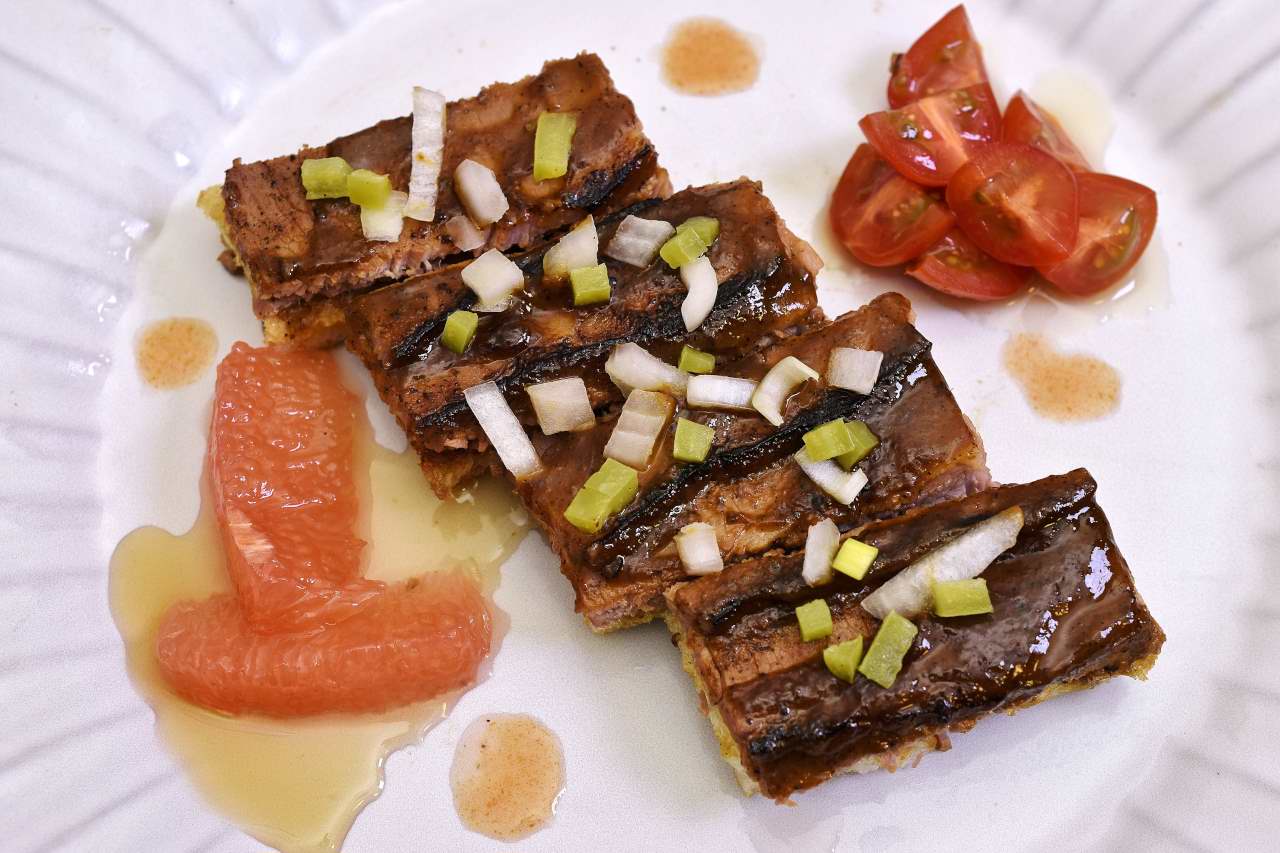
Appetizer sized bbq brisket sandwich with peppers and onions. Grapefruit, rosemary gastrique. Honey glazed tomatoes.

Seemed like a good idea at the time.

It’s just a waffle with some creamed chipped brisket. Even so, the batter is leavened pâte à choux with corn mixed into it…I have this thing for parsley.
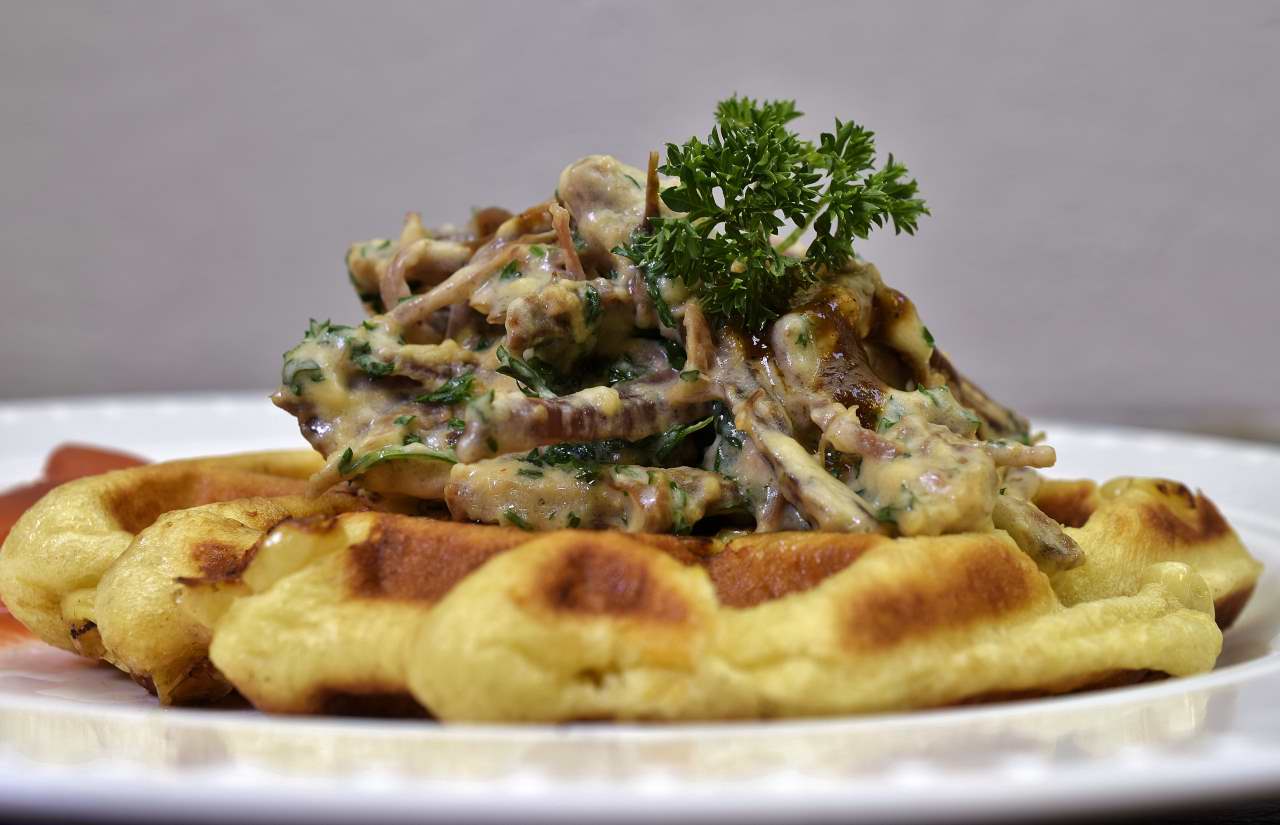
What we used to eat when my parents were out bowling.
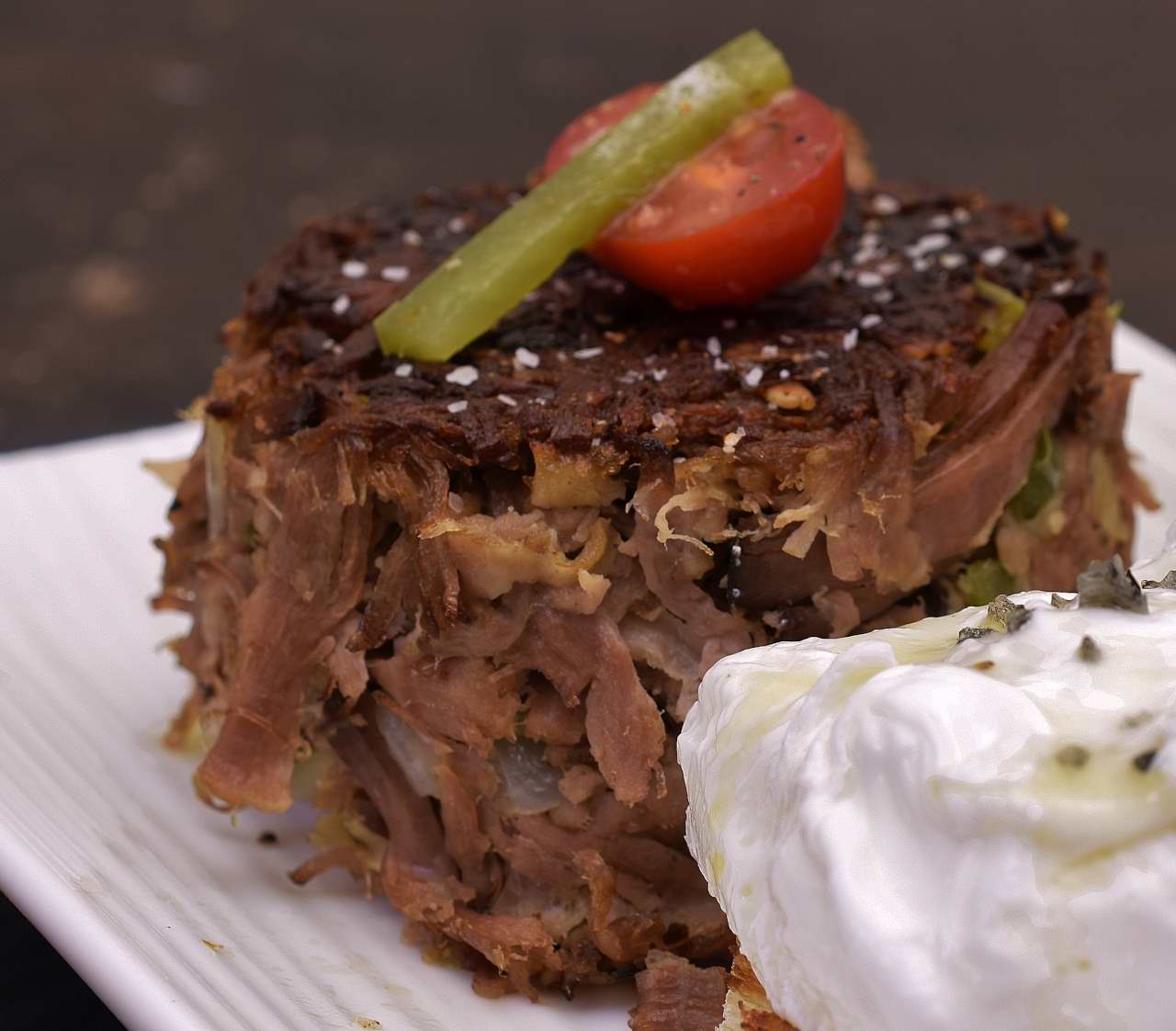
Hash didn’t always come in a can, and wasn’t always corned beef either. This one is brisket. Chi chi restaurants offer prime rib hash for a downtown price. I don’t put potatoes in hash. I use a little oatmeal to hold things together, a little bit of onion, a little bit of green pepper.
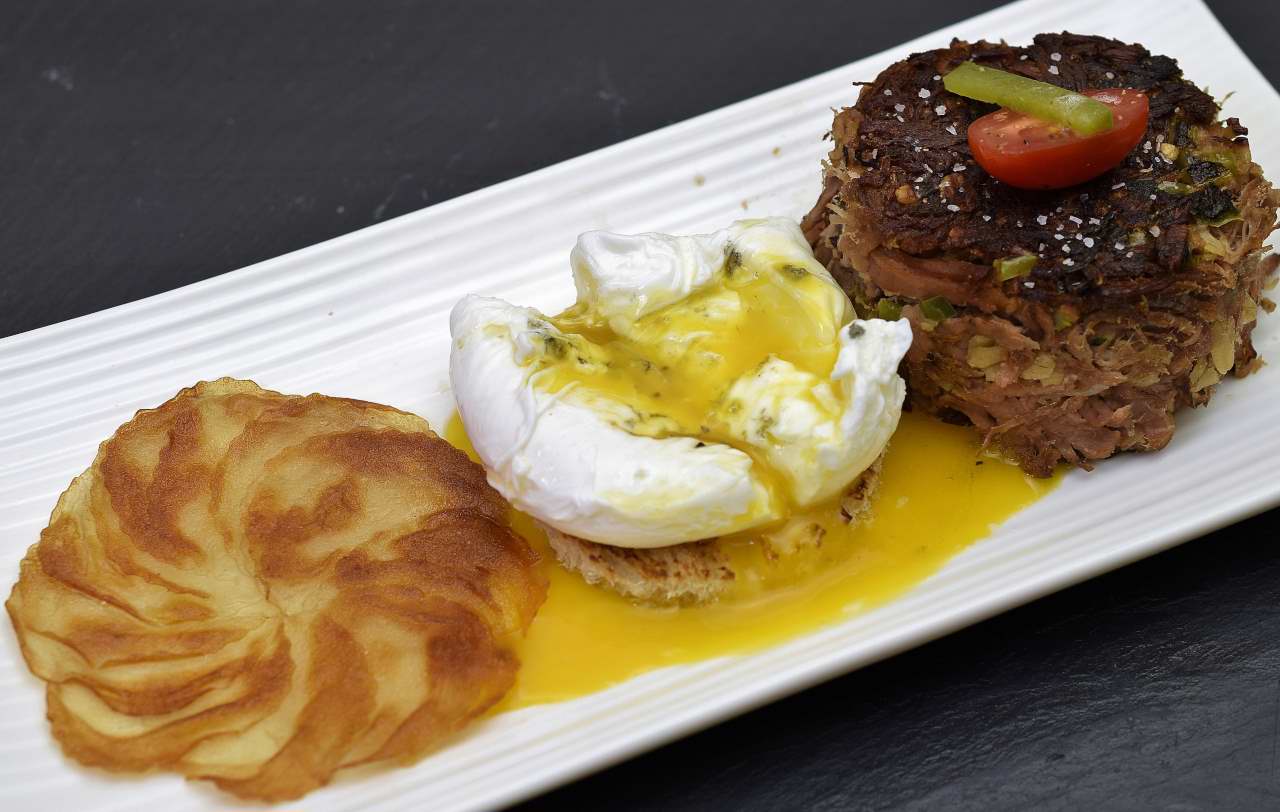
The money shot with the Maxim potatoes.
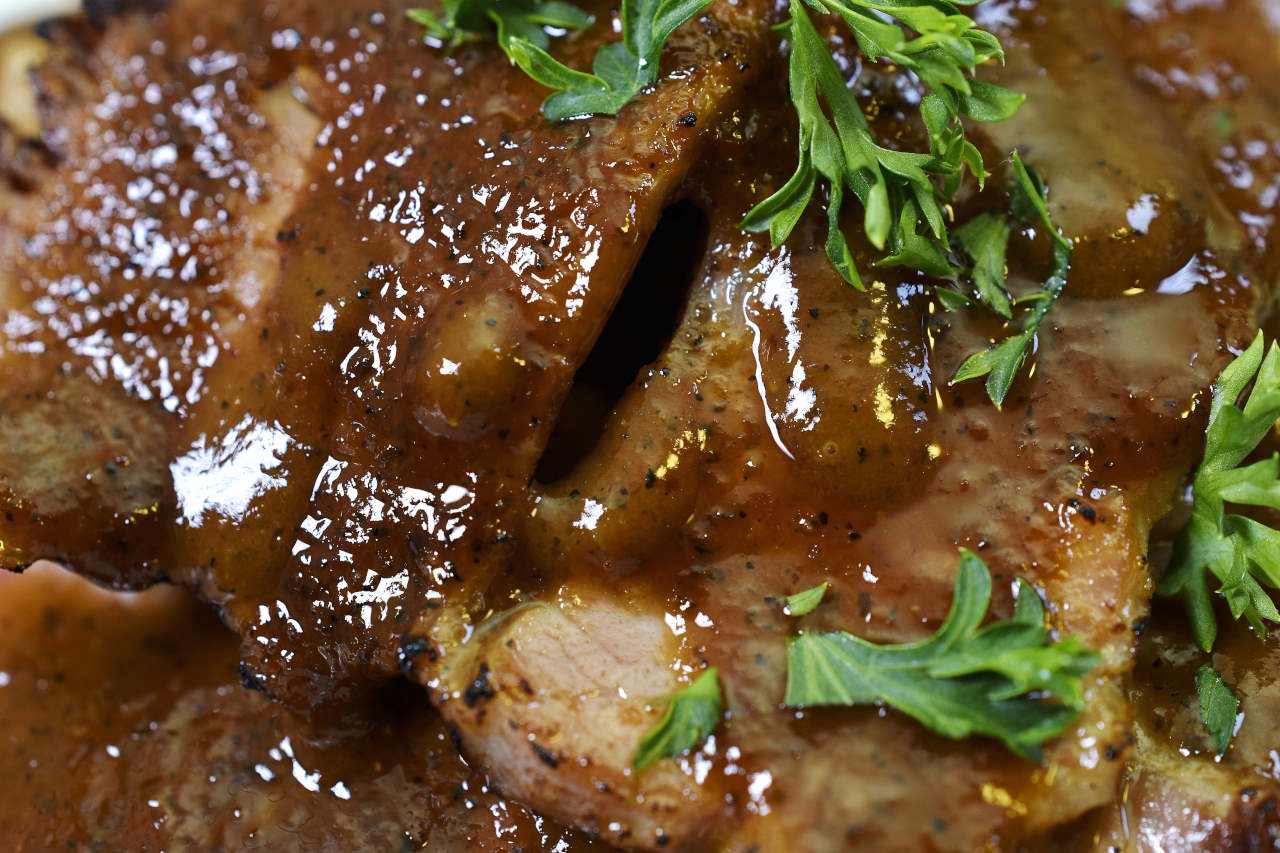
Barbecue entree, the recipe for the sauce is HERE.

Again, parsley. Corn fritter, cured beets, potato salad, you can’t see the popcorn but it’s there.

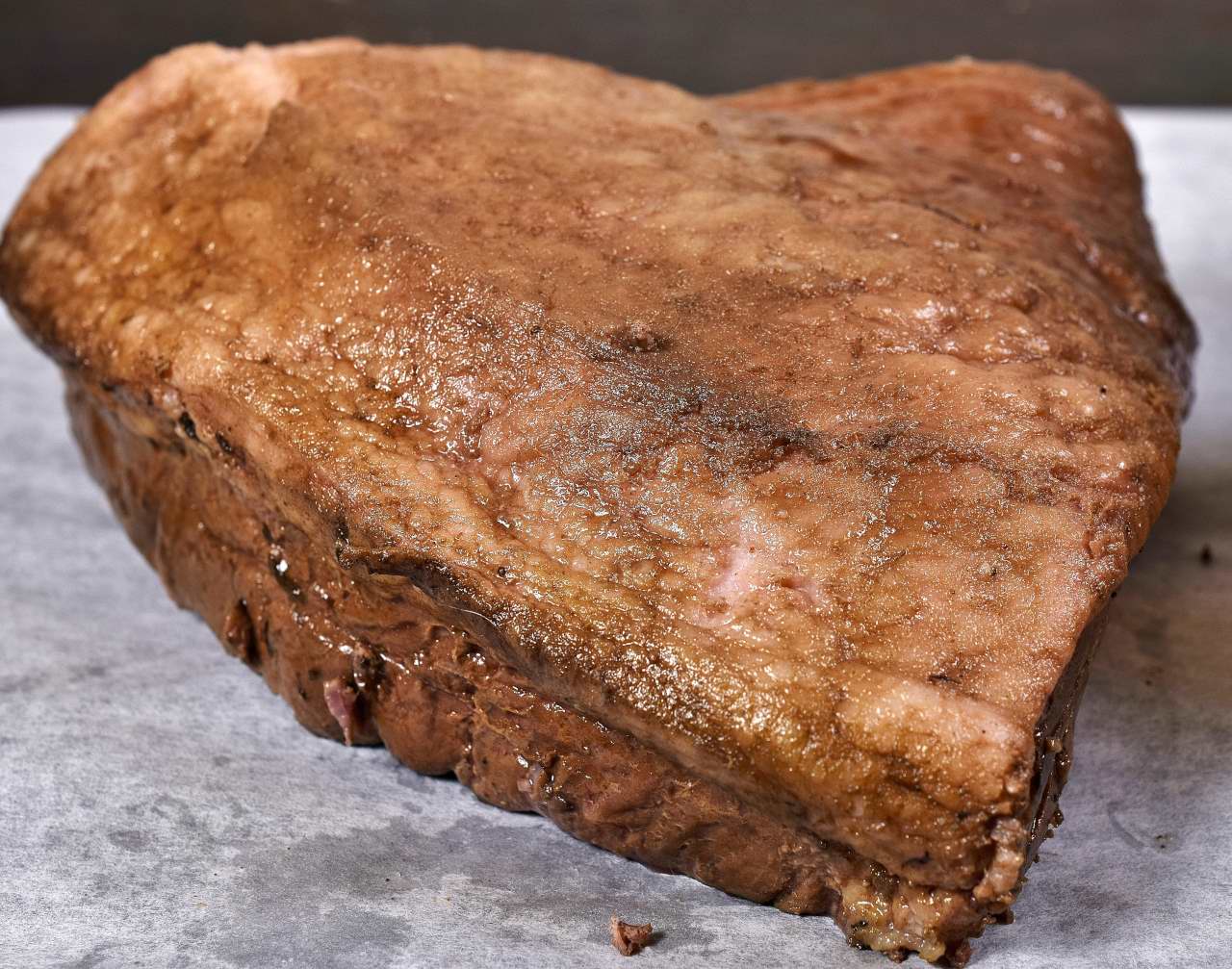
Hi there, I enjoy reading all of your article post.
I wanted to write a little comment to support you.
My webpage vpn special code
magnificent publish, very informative. I ponder why
the other experts of this sector do not notice this. You must continue your writing.
I’m confident, you’ve a great readers’ base already!
My blog: vpn special coupon
I enjoy what you guys are up too. This type of clever work and coverage!
Keep up the terrific works guys I’ve incorporated you guys facebook vs eharmony to find love online my own blogroll.